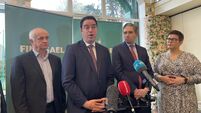Viewers may have to replace TV sets
Yesterday, the Government announced a trial scheme for a digital terrestrial television (DTT) service, which broadcasts via the airwaves to new sets capable of receiving digital signals.
By 2012, the Government plans to axe current analogue transmissions entirely and replace them with broadcasts using digital signals only.
Unless viewers buy new digital TV sets costing hundreds of euro, they will have to subscribe to satellite or cable or buy a €44 electronic box for their existing televisions.
Labour’s communications spokesman Tommy Broughan is calling for the Government to help with the costs faced by households when digital television comes in.
He said: “There are benefits for the television industry but there are also significant costs as well to households and it is important we help people on low incomes.”
Latest figures show the number of televisions in the Republic is at least 1.24 million based on the numbers of TV licences in force.
Each will have to be replaced or connected to a satellite, cable or set-top box, meaning householders will be paying more to watch television in the future.
Yesterday, the Government announced a two-year trial for digital broadcasts transmitted from the Three Rock site in Dublin and also from Co Louth’s Clermont Carn site.
Selected households in the reception area of the digital transmitters will get set-top boxes to link to their existing televisions so they can watch the new broadcasts.
Householders will be able to receive RTÉ, TV3, TG4 and radio stations through the set-top boxes with other channels being added as the tests progress.
Communications Minister Noel Dempsey said: “Digital terrestrial television is capable of providing much more for Irish viewers in the long term in terms of quality, service and additional channels than [the existing] analogue service.
“The European Commission has proposed 2012 as the date by which switch-off of analogue TV could be completed across Europe.
“Our pilot scheme plays an important step in informing the development of Ireland’s long-term broadcasting strategy.”












